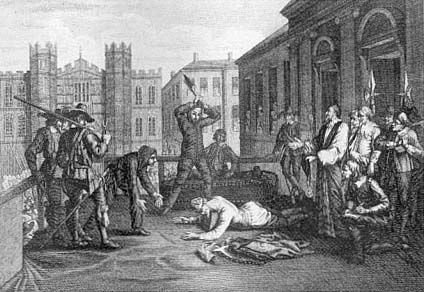Once again, history proves that it's not always good to be the king (or apparently the man who overthrows him either). Charles I was your average inbred near dwarf royalty that much of Europe was popping out at the time. He is listed in the Guinness Book of Records as the nation's shortest king. He married another inbred royal princess (Princess Henrietta Maria of France) and that would have been that. Unfortunately for him, two issues got in his way - his wife was Catholic and after much tsuris, England was in a Protestant mood.
 Also, Charles had picked up the nasty habit of believe in the Divine right of the Monarchy. Parliament was feeling it oats and would have none of it and this lead to the English Civil War. Rather than the Blue and the Grey, England had the Roundheads and the Cavaliers (it really doesn't matter who was who - but it might be on the test.)
Also, Charles had picked up the nasty habit of believe in the Divine right of the Monarchy. Parliament was feeling it oats and would have none of it and this lead to the English Civil War. Rather than the Blue and the Grey, England had the Roundheads and the Cavaliers (it really doesn't matter who was who - but it might be on the test.)Charles and his supported were defeated and Charles was put on a show trial for High Treason. Since Charles believed he had a Divine right to be King, he put up no defense. Parliament, wishing all the best to meet the Divine, convicted him of treason and ordered his execution.
 When Charles was beheaded on January 30th, 1649, it is reputed that he wore two shirts as to prevent the cold January weather causing any noticeable shivers that the crowd could have been mistaken for fear or weakness. He put his head on the block after saying a prayer and signaled the executioner when he was ready; he was then beheaded with one clean stroke.
When Charles was beheaded on January 30th, 1649, it is reputed that he wore two shirts as to prevent the cold January weather causing any noticeable shivers that the crowd could have been mistaken for fear or weakness. He put his head on the block after saying a prayer and signaled the executioner when he was ready; he was then beheaded with one clean stroke.It was common practice for the head of a traitor to be held up and exhibited to the crowd with the words Behold the head of a traitor!; although Charles' head was exhibited, the words were not used. In an unprecedented gesture, one of the revolutionary leaders, Oliver Cromwell, allowed the King's head to be sewn back on his body so the family could pay its respects. Charles was buried in private and at night on February 7th, 1649, in the Henry VIII vault inside St George's Chapel in Windsor Castle.
This was Cromwell's big mistake.
Under Oliver Cromwell, England became a Republic and became Protectorate and ruled England until his death from malaria in 1658. He was succeeded as Lord Protector by his son Richard. Although Richard was not entirely without ability, he had no power base in either Parliament or the Army, and was forced to resign in the spring of 1659, bringing the Protectorate to an end. In the period immediately following his abdication, the head of the army, George Monck took power for less than a year, at which point, Parliament restored Charles II as king.
Now here's the kicker -
 in 1661, Oliver Cromwell's body was exhumed from Westminster Abbey, and was subjected to the ritual of a posthumous execution. Symbolically, this took place on January 30; the same date that Charles I had been executed. As Cromwell was quite dead at the time, he could put up a very weak defense at best. His body was hung in chains at Tyburn. Finally, his disinterred body was thrown into a pit, while his severed head was displayed on a pole outside Westminster Abbey until 1685. Afterward, the head changed hands several times, before eventually being buried in the grounds of Sidney Sussex College, Cambridge, in 1960.
in 1661, Oliver Cromwell's body was exhumed from Westminster Abbey, and was subjected to the ritual of a posthumous execution. Symbolically, this took place on January 30; the same date that Charles I had been executed. As Cromwell was quite dead at the time, he could put up a very weak defense at best. His body was hung in chains at Tyburn. Finally, his disinterred body was thrown into a pit, while his severed head was displayed on a pole outside Westminster Abbey until 1685. Afterward, the head changed hands several times, before eventually being buried in the grounds of Sidney Sussex College, Cambridge, in 1960.
No comments:
Post a Comment